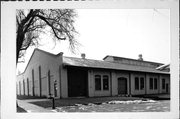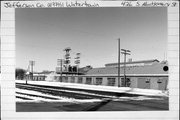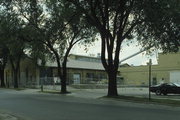| Additional Information: | A 'site file' exists for this property. It contains additional information such as correspondence, newspaper clippings, or historical information. It is a public record and may be viewed in person at the Wisconsin Historical Society, State Historic Preservation Office.
This is the second and largest location of the G.B. Lewis Company, an important wood-products manufacturing concern of the nineteenth and early twentieth century.
The Lewis Company was an outgrowth of the popular sash and door mills of the mid-nineteenth century. George B. and Robert E. Lewis began a millwork factory in 1863 in Patrick Rogan's old sawmill at the middle dam. Successful, by 1878 the firm was known as Lewis and Parks and had branched out into making wooden supplies for beekeepers, who at that time, were numerous in Wisconsin and in the area. By 1880 the company was known as the G. B. Lewis Company, specializing in products known as "Beeware." In 1885 the company perfected an idea for a wooden box made of thin slats of wood. This slat box was cheap to manufacture and light-weight. It became a very popular item for transporting fragile, yet light items, such as bread. As the G.B.. Lewis Company expanded they enlarged the Rogan Mill and eventually replaced it with a large wooden building at the middle dam. A major fire, one of the largest fires in Watertown history, destroyed this factory in 1909. No longer needing water power to operate their plant, they moved to this site. They began with a small group of buildings at this site, but by 1926, the site included most of the buildings here today. By the mid-twentieth century, G.B. Lewis was manufacturing Beeware, slat containers, golf supplies and other miscellaneous wood products. Between the mid-1950s and the present time, G.B. Lewis has increasingly branched out into manufacturing plastic products, particularly materials handling containers for industrial use. This line has totally overtaken the company and during the 1970s G.B. Lewis became part of the Menasha Corporation. Today, they manufacture plastic goods exclusively under the name of the Menasha Corporation.
Several structures in this factory complex are significant for local history under National Register criterion A, because they are the only and best resource connected to the G.B. Lewis Company, one of Watertown's most successful and important businesses.
Watertown's pioneer wood products industries: sawmills, sash and door factories, and cooper shops all disappeared after the turn of the century. But there were several unusual wood-products industries that survived and became large employers. One of these was the G.B. Lewis Company. The company grew from a small shop to a large factory complex. While this site is not the original factory site or building, it represents the company's successful recovery from a devastating fire to become a modern and successful twentieth century corporation.
The new construction and remodeling of this complex during the past few decades has compromised many of the historic structures. However, the brick buildings on the site are original to 1909 and retain, at this time, enough of their historic character to meet the eligibility criteria for local history.
A complex of industrial buildings constructed mainly between the years 1909 and 1926, the G.B. Lewis Company buildings are utilitarian early 20th century buildings that still exhibit some historic influences. Now painted, the brick surfaces are divided vertically by applied brick pilasters and articulated by paired segmental arched windows as well as large rectangular multipaned windows (some are now filled in). The gabled end walls rising above the roof are topped by tile coping. A gable roofed monitor or clerestory is located on the roof. Many extensions and additions are located at the rear of the main building.
One of the few extant historic industrial buildings in the city of Watertown, the G.B. Lewis Company Buildings have retained a fair degree of integrity. Although historically significant, these unremarkable buildings have been altered considerably and do not meet the criteria for architectural significance. Other better preserved historic industrial buildings in a similar style include the Van Camp Plant at 500 Milford (58-29) and the Biefeed Building at 118 No. Water. |
|---|
| Bibliographic References: | (A) Sanborn-Perris Insurance Maps 1901, 1909, 1915, 1926.
(B) "G.B. Lewis Company is One of World's Largest Manufacturers of Beeware," Watertown Daily Times Centennial Issue, June 26, 1954, n.p.
(C) Watertown Wisconsin Centennial 1854-1954, Watertown: Jansky Printing Co., 1954, p. 21.
(D) G.B. Lewis newspaper subject file, Watertown Public Library.
Watertown Daily Times 2/6/1982. |
|---|



